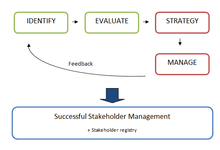Stakeholder approach
.svg.png)
A stakeholder approach suggests that managers should formulate and implement processes which satisfy stakeholders' needs in order to ensure the long-term success of the firm.[1] According to the degree of participation of the different groups, the company can take advantage of market imperfections in order to create valuable opportunities. It emphasizes active management of the business environment, relationships and the promotion of shared interests.[2] This approach is based on the stakeholder theory which arises as a counterpart to the dominant way of understanding business and management that is focused on shareholders satisfaction. [3] The implementation of this approach can reinforce the firm values and create competitive advantage. However, it has been criticized for overvaluing stakeholders and its difficulty to reach consensus.

Utility
Competitive advantage
This approach is more able to create competitive advantage because it creates a link between the firm and stakeholders. The latter will perceive the coherent application of the organizational values and will relate those values with his own. In that way, the company will have the needed information about stakeholders in order to treat them well and develop important initiatives. By doing that, the firm’s reputation and loyalty will be reinforced among customers and other stakeholders alike, it will create stronger brand recognition and will increase trust in the firm. Even if there are limits in loyalty and reputation can be damaged, those two key elements can make a big difference creating barriers to other companies that may want to have information about stakeholder utility functions. A firm that follows the stakeholder approach will get the information needed to work for satisfying the stakeholders’ needs, making it easier to develop expertise. Those acquired skills can be transmitted, promoted and reinforced across the business operation of the firm creating core competencies. Over time, this approach can become an indispensable issue in the organizational culture.[4][5]
Value creating through innovation
Firms that manage for stakeholders are more able to attract a higher-quality workforce. Employees’ job satisfaction has an impact on the firm’s ability to foster innovation. Workers who are satisfied with their jobs are more likely to engage in long-term thinking and generate potentially valuable ideas. Those firms can use information about stakeholder to devise new ways of satisfying them.[6] Reciprocity is a key aspect in this approach: when stakeholders stand to benefit, they are more likely to reveal information about their utility function. That is why firms and firm managers can better meet consumers' needs by understanding their own customers and suppliers and using this information strategically and flexibly.[5]
Limits
Divergent interests
The implication of all the stakeholders may produce divergent views making it difficult to reach consensus.[7] Each stakeholder may care mostly about its own benefits or self-interests.[8] Trying to satisfy a large number of players will complicate governance.[9] It can result in time consuming in engaging all the parties. Moreover, in this approach, an equality of stakeholders and business is implied in negotiating issues of mutual interest. That assumption has been critiqued in terms of an inequality of resources, negotiating power and time required. The identification of prices and opportunity costs for the different stakeholders difficult and reduce the operability of this approach.[7]
Overvaluing stakeholders
Another critic to this approach is that a firm can be so much concentrated in getting information about stakeholders' utility function that its costs can exceed the benefits. Therefore, in its intention to create value, managing for stakeholders can end up allocating too many resources to stakeholders. Also, having into account that the power among stakeholders is not equal, some powerful actors can get much of the firm’s profitability. And with that distribution of value, shareholders cannot expect a maximization of returns.[5]
External links
- Competitive advantage - Strategic Management Inside
- Negotiation power - Program on negotiation. Harvard Law School
- Innovation - Australian government. Department of Industry, Innovation and Science.
Further reading
Watkins, M. (2013) - Harvard Business Review. What Is Organizational Culture? And Why Should We Care?
Smallwood, N. (2010) - Harvard Business Review. Four Ways to Create Intangible Value
References
- ↑ Post, James E.; Preston, Lee E.; Sachs, Sybille (2002-10-01). "Managing the Extended Enterprise: The New Stakeholder View". California Management Review. 45 (1): 6–28. ISSN 0008-1256. doi:10.2307/41166151.
- ↑ Freeman, R. Edward; McVea, John (2001-01-01). "A Stakeholder Approach to Strategic Management". SSRN 263511
 .
. - ↑ Freeman, R. Edward; Harrison, Jeffrey S.; Wicks, Andrew C.; Parmar, Bidhan L.; Colle, Simone de (2010-04-01). Stakeholder Theory: The State of the Art. Cambridge University Press. ISBN 9781139484114.
- ↑ Maignan, Isabelle; Gonzalez, Tracy; Hult, Tomas; Ferrell, O.C. (25 July 2011). "Stakeholder orientation: development and testing of a framework for socially responsible marketing". Journal of Strategic Marketing. 19: 313–338.
- 1 2 3 Harrison, Jeffrey S.; Bosse, Douglas A.; Phillips, Robert A. (2010-01-01). "Managing for Stakeholders, Stakeholder Utility Functions, and Competitive Advantage". Strategic Management Journal. 31 (1): 58–74. JSTOR 27735509.
- ↑ Flammer, Caroline; Kacperczyk, Aleksandra (2014-08-19). "The Impact of Stakeholder Orientation on Innovation: Evidence from a Natural Experiment". SSRN 2353076
 .
. - 1 2 O’Haire, Christen; McPheeters, Melissa; Nakamoto, Erika; LaBrant, Lia; Most, Carole; Lee, Kathy; Graham, Elaine; Cottrell, Erika; Guise, Jeanne-Marie (2011-06-01). Strengths and Limitations of Stakeholder Engagement Methods. Agency for Healthcare Research and Quality (US).
- ↑ "The Risks of Relying on Stakeholder Engagement for the Achievement of Sustainability (PDF Download Available)". ResearchGate. Retrieved 2017-05-06.
- ↑ Oubihi, Jamila (April 2016). "The Stakeholder Value: Contributions and Limitations" (PDF). International Journal of Business and Social Science. 7: 86–90.